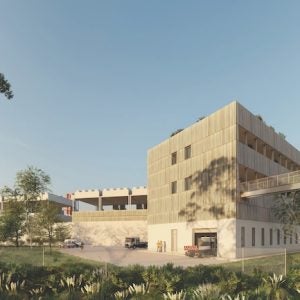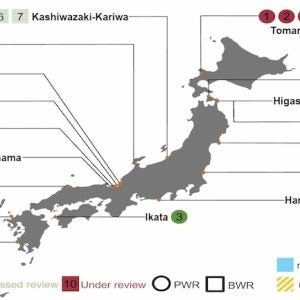Fluid bed combustion technology has continued to evolve from the initial clean coal and PURPA projects in the USA to what is now essentially worldwide market penetration. The major drivers behind the use of CFB (circulating fluid bed) technology are the potential to make use of lower cost fuels and a heightened environmental sensitivity to power plant emissions.
Due to its fuel versatility and ability to reduce emissions, CFB technology is particularly well-suited to meet these and other power generation challenges and as a result the unit size has been steadily increasing, now exceeding 300 MWe. Since 1981, Alstom has supplied 103 units, totalling about 8500 MWe and some of the company’s largest and most advanced CFBs are due to go commercial this year, including the two 250 MWe Puerto Rican units.
Independent power project
With electricity consumption growing at 3 per cent annually and a need to maintain relatively high reserve margins, Puerto Rico’s government-owned electric utility, the Puerto Rico Electric Power Authority (PREPA), began in the late 1990s to diversify its generation mix and modernise its infrastructure. As part of that plan, it decided to allow independent power production and cogeneration as a way to secure additional low cost energy for its 1.3 million customers. One of the island’s first independent power producers will also be Puerto Rico’s first ever coal-fired power station: the 454 MW AES Puerto Rico Total Energy Plant.
To alleviate any potential environmental concerns over burning coal, the plant is powered by two (CFB) boilers, as well as an assortment of other emissions control technologies that will make it one of the cleanest coal-fired power plants in the world.
Specifically, CFB technology will be combined with selective non-catalytic reduction systems (SNCR) for NOx, dry scrubbers for SO2, and electrostatic precipitators for particulate collection. This system will reduce emissions to levels virtually unheard of in today’s global power markets.
The AES Puerto Rico project is being developed by US-based AES Corporation. The plant is located on an 80 acre site about 5 km west of Guayama in the southeastern region of Puerto Rico. It is scheduled to begin commercial operation in late-2002, burning low-sulphur coal imported from South America and other sources. Duke/Fluor Daniel, a joint venture of Duke Energy Corp and Fluor Corp, was chosen by AES to design, procure and construct the plant.
Upon commercial operation, approximately 400 000 lb/h of process steam will be delivered to Chevron Phillips Corp (CPPO), a nearby petrochemical plant. In addition, the plant will provide electricity and a percentage of its steam to CPPO as a qualifying facility (QF). Each of the AES Puerto Rico units will produce some 1 824 325 lb/h main steam and 1 569 600 lb/h of reheat steam.
The design of the plant’s CFB units is based on Alstom’s Tonghae project in South Korea, which is rated at about 220 MWe per unit.
The boilers consist of a single cell design, with an internal evaporator surface and superheater and reheater fluid bed heat exchangers. Four light oil, air atomised burners are located within the furnace. The coal will be crushed and stored in silos, and then fed to the furnace via eight (per-unit) gravimetric feeders, with feed sloped chutes with a hot primary air assist.
Each unit will produce 2520 psi steam, with 1005°F superheat and reheat steam temperatures. In addition to the low combustion temperatures, NOx control will be enhanced by distributing secondary air to the combustor front and rear walls. Further NOx control will be achieved through the use of the SNCR.
The steam is fed to two Alstom 255 MW steam turbine generator sets using an air cooled (Topair) generator rated at 300 MVA, 21 kV.
Each turbine set features a two casing design employing a high pressure (HP) turbine and an intermediate pressure/low pressure (IP/LP) turbine to optimise plant efficiencies.
The plant’s coal will be delivered via self-discharging vessels at Puerto Rico’s Las Mareas Port, just south of the plant site. A new dock facility has been built in the harbour, where the coal will be unloaded and transported to the plant via covered conveyors.
Since the plant is relatively close to the Las Mareas Harbour, Alstom shipped a number of major boiler components pre-assembled to reduce on-site construction times. For example, large sections (28 ft x 30 ft) of the cyclones were pre-assembled and offloaded directly from ocean going vessels to the harbour unloading area. Heavy haul transport trailers then brought the components up to the construction site. In addition, a number of other large components, such as the three fluid bed heat exchangers (FBHE), weighing over 370 tons each, were assembled outside the boiler structure while steel was being erected, then placed inside the structure once the steel construction was completed.
Emissions control
A key factor in obtaining the necessary environmental permits for the plant involved its use of CFB technology. The technology’s fuel flexibility allows power plant owners to lower fuel costs by burning less expensive fuels like coal while still meeting stringent environmental requirements.
The environmentally attractive features of the CFB result from its inherent combustion characteristics. Sulphur dioxide (SO2) is captured in the combustion process by adding limestone to the fluidised bed. Because the combustion temperatures remain in the 1500 to 1600°F range – as compared with 2500-3000°F for conventional technologies – NOx formation is also reduced during combustion.
Due to the sensitivities associated with burning coal, the air emissions control system for AES Puerto Rico also includes an SNCR for additional NOx emission control, a dry scrubber for additional SO2 emission control, and an electrostatic precipitator (ESP) for particulate emission control.
Each piece of equipment, except the dry scrubber, has been successfully used on other CFB applications. Dry scrubber technology is well proven on other types of boiler.
ESPs are an appropriate technology to follow the dry scrubber because of the high concentration of dust in the scrubber outlet gases. The collected particulate is immediately removed from the flue gas stream. The low temperatures and high humidity of the CFB gases help maximise the ESP’s capabilities to handle multiple fuels.
The overall, projected emissions for the AES Puerto Rico Plant are as follows:
• Total NOx emissions in the flue gas will be limited to 57 ppmvd at 7 per cent O2, 0.1 lb/Mbtu, or 246 lb/h, whichever is more stringent. The SNCR system, using urea reagent, will reduce the NOx emissions to compliance levels, with the emissions measured and determined over a 24-hour period using a rolling average.
• Total SO2 emissions in the flue gas will not exceed the more stringent of either 9.0 ppmvd at 7 per cent O2, 0.022 lb/MBtu, or 54.1 lb/h. About 70 per cent of the SO2 formed during the combustion of sulphur in the fuel will be captured internally by the calcium oxide generated from the calcination of the limestone in the CFB combustor. In addition, the dry scrubber will use water and dry lime to reduce the flue gas temperature and react with SO2 to form calcium sulphite. The SO2 emissions will be determined over an eight-hour period.
• The ESP will control particulates leaving the flue gas stream from both the CFB and the dry scrubber. This equipment is capable of meeting the emission rate for both particulate matter (PM) and PM smaller than 10 microns (PM10) of 0.015 lb/MBtu and providing plume opacity of less than 20 per cent based on a six minute average. The plant’s environmental permit also requires a removal efficiency of at least 99 per cent.
• Total carbon monoxide (CO) emissions will be limited to the more stringent of 94 ppmvd at 7 per cent O2, 0.10 lb/MBtu, or 246.1 lb/h. Performance of existing Alstom CFB boiler installations indicates this level of CO emissions is achievable without supplemental or post-combustion CO reduction equipment.
• Volatile organic compound (VOC) emissions in the flue gas are limited to the more stringent of 7.7 ppmvd at 7 per cent O2, 0.0047 lb/MBtu, or 11.6 lb/h. Performance at existing Alstom CFB installations indicates this VOC emissions level is also achievable without supplemental or post-combustion VOC reduction equipment.
• Sulphuric acid mist emissions will be limited to 0.64 ppmvd at 7 per cent O2, 0.024lb/Mbtu, or 5.9 lb/h, whichever is more stringent.
• Fluorides emissions will be limited to 0.000478 lb/Mbtu, or 1.18 lb/h, whichever is more stringent.
• Emissions of ammonia will be limited to 10 ppmvd at 7 per cent O2. Limiting the ammonia injection for SNCR NOx control will limit the ammonia emissions.
A continuous emissions monitoring system (CEMS) will allow the authorities to measure compliance. The system monitors SO2, CO, O2, NOx and NH3, using an extraction-type system with dilution-type probes located in the ducts at the scrubber entrances and the ESP outlets.
Each boiler has an independent set of analysers. The system is configured to allow either bank of analysers to operate in a “time share” configuration in the event of an analyser failure. The CEMS will provide process data information to the control room via the plant’s distributed control system. Also a single opacity monitor per unit will be located in each flue of the stack, with the data acquisition computer located in the control room.
Reduced water usage
Due to the premium placed on Puerto Rico’s water supply, a number of steps were taken to minimise the plant’s use of fresh water:
• The facility is designed for zero discharge of water used in the process and/or runoff water from the fuel storage area.
• Treated effluent from the regional sewage treatment plant in Guayama is used in the plant for cooling tower makeup and cooling the flue gas in the dry scrubber, thus eliminating most of the water that is currently being discharged into the sea by this treatment facility. This also reduces the dependency on local fresh water sources and eliminates the need to use seawater.
• After receiving up to 400 000 lb/h of process steam, CPPO will return condensate and other makeup water via a specially-designed piping system to be used again.
Continued viability of coal
As well as protecting Puerto Rico’s pristine, natural beauty, the AES project will also contribute to PREPA’s corporate objectives, which include increasing its system-wide electrical capacity, providing its customers with relatively stable electricity rates, and maintaining its relatively high reserve margins.
Through the use of CFB boilers and other emissions control technologies, the project also demonstrates the continued viability of coal as a power generation fuel – particularly on an island up to now dependent upon much more expensive imported fuel oil.
Tables
Properties of the coal (South American/bituminous) to be used in Puerto Rico plant






